Biology > QUESTIONS & ANSWERS > Chapter 20—THE PROTISTS: All The Answers.. (All)
Chapter 20—THE PROTISTS: All The Answers..
Document Content and Description Below
1. The simplest of the eukaryotes are the: a. protistans b. plants c. fungi d. animals e. Archaea a POINTS: 1 REFERENCES: Section 20.1 What are protists? KEYWORDS: Blo... om's: Remember 2. All protists have: a. chloroplasts only b. nuclei only c. mitochondria only d. both nuclei and mitochondria e. chloroplasts, nuclei, and mitochondria b POINTS: 1 REFERENCES: Section 20.1 What are protists? KEYWORDS: Bloom's: Remember Selecting the Exception 3. Four of the five answers listed below are members of the same kingdom. Select the exception. a. Archaea b. protozoa c. charophyte d. dinoflagellate e. euglenoid a POINTS: 1 REFERENCES: Section 20.1 What are protists? KEYWORDS: Bloom's: Remember OTHER: Selecting the Exception 4. Four of the five answers listed below are protistan structures. Select the exception. a. cell membrane b. pili c. mitochondrion d. eyespot e. pellicle b POINTS: 1 REFERENCES: Section 20.1 What are protists? KEYWORDS: Bloom's: Understand OTHER: Selecting the Exception 5. Four of the five groups listed below have single-celled members. Select the exception. a. brown algae b. dinoflagellates c. green algae d. diatoms e. red algae a POINTS: 1 REFERENCES: Section 20.6 What are stramenopiles? KEYWORDS: Bloom's: Remember OTHER: Selecting the Exception 6. Four of the five answers are characteristics of diatoms. Select the exception. a. two-part silica shells b. photosynthetic c. some produce a toxin that accumulates in fish, crabs, and shellfish d. flagella e. live in lakes, seas, and damp soils d POINTS: 1 REFERENCES: Section 20.6 What are stramenopiles? KEYWORDS: Bloom's: Remember NOTES: Modified 7. Four of the five answers listed below are amoeboid protozoans. Select the exception. a. amoebas b. cellular slime molds c. plasmodial slime molds d. Dictyostelium e. diatoms e POINTS: 1 REFERENCES: Section 20.8 What are amoebozoans? KEYWORDS: Bloom's: Remember OTHER: Selecting the Exception 8. If a chloroplast in a protist has four membranes, it arose from: a. primary endosymbiosis b. secondary endosymbiosis c. tertiary endosymbiosis d. protist cell fusion e. protist organelle replication b POINTS: 1 REFERENCES: Section 20.1 What are protists? KEYWORDS: Bloom's: Understand NOTES: New 9. What is a protist? a. A prokaryote that is not bacteria b. A prokaryote that is not bacteria or archea c. A eukaryote that is not an animal, but may be a plant d. A eukaryote that is not an animal or plant, but may be fungi e. A eukaryote that is not an animal, plant, or fungi e POINTS: 1 REFERENCES: Section 20.1 What is a protist? KEYWORDS: Bloom's: Remember NOTES: New 10. Cells of a ____ organism live together, but remain self-sufficient. a. single-cell b. multicellular c. colonial d. eukaryotic e. protist c POINTS: 1 REFERENCES: Section 20.1 What is a protist? KEYWORDS: Bloom's: Understand NOTES: New 11. Which flagellate(s) have modified mitochondria and make ATP without oxygen? a. trypanosomes b. euglenoids c. rhizarians d. diplomonads and parabasalids e. diatoms and brown algae d POINTS: 1 REFERENCES: Section 20.2 What are flagellated protozoans? KEYWORDS: Bloom's: Understand NOTES: New 12. A contractile vacuole is important to euglenoids for: a. photosynthesis b. food storage c. excess water removal d. movement e. structure c POINTS: 1 REFERENCES: Section 20.2 What are flagellated protozoans? KEYWORDS: Bloom's: Remember 13. The pellicle of protozoa is most directly involved in: a. feeding b. information storage c. locomotion d. structure e. water removal d POINTS: 1 REFERENCES: Section 20.2 What are flagellated protozoans? KEYWORDS: Bloom's: Remember 14. Trypanosomes that infect humans are transmitted by: a. biting insects b. contaminated water c. contaminated food d. aerosols e. parasitic worms a POINTS: 1 REFERENCES: Section 20.2 What are flagellated protozoans? KEYWORDS: Bloom's: Remember NOTES: Modified 15. What is the layer of elastic proteins beneath the cell membrane of protozoans? a. eyespot b. pellicle c. feeding groove d. flagella e. cell wall b POINTS: 1 REFERENCES: Section 20.2 What are flagellated protozoans? KEYWORDS: Bloom's: Remember NOTES: New 16. Which species causes the waterborne disease giardiasis? a. euglenoids b. trypanosomes c. diplomonads d. parabasalids e. any anaerobic protozoans c POINTS: 1 REFERENCES: Section 20.2 What are flagellated protozoans? KEYWORDS: Bloom's: Remember NOTES: New 17. Foraminiferan and radiolarian lineages are related, but different in that: a. one has a mineral based shell and the other does not b. one has a chalk shell and the other has a silica shell c. one has a shell and one does not have a shell d. one is heterotrophic and the other is completely autotrophic e. one has a single, large mitochondria and the other has many b POINTS: 1 REFERENCES: Section 20.3 What are Rhizarians? KEYWORDS: Bloom's: Understand NOTES: Modified 18. Planktonic foraminifera often have smaller photosynthetic protists such as diatoms or algae ____. a. living inside them b. living on their shell c. living near them on the ocean floor d. aiding in the building of their shell e. providing carbon dioxide for them a POINTS: 1 REFERENCES: Section 20.3 What are Rhizarians? KEYWORDS: Bloom's: Remember NOTES: New 19. Foraminifera help the sea to absorb more carbon dioxide from the air by: a. photosynthesis b. incorporating it into their calcium carbonate shells c. incorporating it into their silica shells d. storing it in their gas filled vacuoles e. digesting photosynthetic plankton species b POINTS: 1 REFERENCES: Section 20.3 What are Rhizarians? KEYWORDS: Bloom's: Understand NOTES: New 20. What is in the outer cytoplasmic layer of radiolaria? a. nucleus b. contractile vacuoles c. algae d. mitochondria e. gas filled vacuoles e POINTS: 1 REFERENCES: Section 20.3 What are Rhizarians? KEYWORDS: Bloom's: Remember NOTES: New 21. The presence of ____ in rock help geologists locate deposits of oil. a. red algae b. flagellated protozoans c. amoebas d. rhizarian shell fossils e. brown algae d POINTS: 1 REFERENCES: Section 20.3 What are Rhizarians? KEYWORDS: Bloom's: Remember NOTES: New 22. Paramecium is a representative of the: a. sporozoans b. amoebas c. flagellates d. euglenoids e. ciliates e POINTS: 1 REFERENCES: Section 20.4 What are alveolates? KEYWORDS: Bloom's: Remember 23. Gut-dwelling ____ help cattle, sheep and related grazing animals break down ____ in plant material. a. ciliates; chlorophyll b. apicomplexans; cellulose c. dinoflagellates; cellulose d. dinoflagellates; chlorophyll e. ciliates; cellulose e POINTS: 1 REFERENCES: Section 20.4 What are alveolates? KEYWORDS: Bloom's: Understand 24. Which protists have two flagella that make them spin and move forward? a. dinoflagellates b. ciliates c. apicomplexans d. rhizarians e. euglenoids a POINTS: 1 REFERENCES: Section 20.4 What are alveolates? KEYWORDS: Bloom's: Remember NOTES: New 25. Which protist has a belt-like flagellum that runs through a groove in the middle of its cell? a. dinoflagellates b. ciliates c. apicomplexans d. euglenoids e. trypanosomes a POINTS: 1 REFERENCES: Section 20.4 What are alveolates? KEYWORDS: Bloom's: Remember NOTES: New 26. Which specialized structure is not correctly paired with its actual function? a. gullet − ingestion b. cilia − food gathering c. contractile vacuole − digestion d. cilia − locomotion e. micronucleus - sexual reproduction c POINTS: 1 REFERENCES: Section 20.4 What are alveolates? KEYWORDS: Bloom's: Remember NOTES: Modified 27. Which organism has a structure made of microtubules that allows it to penetrate its host? a. apicomplexa b. ciliate c. dinoflagellate d. foraminifera e. radiolaria a POINTS: 1 REFERENCES: Section 20.5 How does malaria affect human health? KEYWORDS: Bloom's: Remember 28. Which organism causes malaria? a. apicomplexa b. ciliate c. dinoflagellate d. foraminifera e. radiolaria a POINTS: 1 REFERENCES: Section 20.5 How does malaria affect human health? KEYWORDS: Bloom's: Remember 29. Over 90% of the worldwide deaths from malaria in 2011 occurred in: a. Africa b. India c. Mexico d. Southeast Asia e. South America a POINTS: 1 REFERENCES: Section 20.5 How does malaria affect human health? KEYWORDS: Bloom's: Remember NOTES: New 30. The parasite Plasmodium reproduces in which cells of the human body? a. brain b. digestive tract c. kidney d. red blood cells and liver e. white blood cells d POINTS: 1 REFERENCES: Section 20.5 How does malaria affect human health? KEYWORDS: Bloom's: Remember NOTES: Modified 31. Kelp and other seaweed are an example of: a. red algae b. green algae c. brown algae d. golden algae e. euglenoids c POINTS: 1 REFERENCES: Section 20.6 What are stramenopiles? KEYWORDS: Bloom's: Remember NOTES: Modified 32. A source for alginic acid, a thickening, emulsifying agent found in ice cream, toothpaste, pudding and cosmetics, are the: a. seed plants b. ferns c. brown algae d. red algae e. green algae c POINTS: 1 REFERENCES: Section 20.6 What are stramenopiles? KEYWORDS: Bloom's: Remember 33. The failure of the potato crop and the subsequent Irish famine in the mid-1800s was due mainly to which group? a. slime molds b. imperfect fungi c. club fungi d. ascomycetes e. stramenopiles e POINTS: 1 REFERENCES: Section 20.6 What are stramenopiles? KEYWORDS: Bloom's: Remember NOTES: Modified 34. Which stramenopiles are photosynthetic? a. diatoms only b. brown algae only c. water molds only d. diatoms and brown algae only e. diatoms, brown algae and water molds d POINTS: 1 REFERENCES: Section 20.6 What are stramenopiles? KEYWORDS: Bloom's: Remember NOTES: Modified 35. The largest protistans would be included in which group? a. brown algae b. golden algae c. red algae d. green algae e. blue-green algae a POINTS: 1 REFERENCES: Section 20.6 What are stramenopiles? KEYWORDS: Bloom's: Remember 36. Like plants, and unlike most other green algae, ____ cells divide their cytoplasm by cell plate formation and have plasmodesmata (cytoplasmic connections between neighboring cells). a. Chlamydomonas b. Volvox c. charophyte d. sea lettuce e. Ulva c POINTS: 1 REFERENCES: Section 20.7 Which protists are closest to plants? KEYWORDS: Bloom's: Understand NOTES: New 37. Freshwater algae belong to which group? a. red algae b. green algae c. dinoflagellates d. brown algae e. golden algae b POINTS: 1 REFERENCES: Section 20.7 Which protists are closest to plants? KEYWORDS: Bloom's: Remember 38. The algal group most like green plants is the: a. Chlorophyta b. charophytes c. brown algae d. dinoflagellates e. red algae 39. What is a colonial green algae that forms the whirling spheres found in fresh water? a. nori b. Porphyra c. kelp d. Volvox e. Ulva 40. Red algae: a. can live at greater depths than green algae b. are thought to have developed from green algae c. contain xanthophylls as their main accessory pigments d. contain no chlorophyll a e. are mostly freshwater algae 41. Agar and carrageenan are extracted from ____ for use as thickeners or stabilizers in foods, cosmetics, and personal care products. a. brown algae b. red algae c. green algae d. brown algae and green algae e. red algae and green algae 42. Nori, used to wrap sushi, is: a. red algae b. green algae c. brown algae d. golden algae e. diatoms 43. Slime molds are classified as: a. protists b. fungi c. bacteria d. archaea e. algae 44. Amoebozoans are heterotrophic protists with cells that lack ____; therefore, they can constantly change shape. a. cell junctions b. a cytoskeleton c. a cell membrane d. a cell wall or pellicle e. pseudopods 45. Of the amoebozoans, which species spend their entire lives as single cells? a. all slime molds b. cellular slime molds c. plasmodial slime molds d. amoebas e. spore-bearing fruiting bodies 46. Which amoebozoan spends most of their life cycle as a multinucleated mass that streams along surfaces, feeding on microbes and organic matter? a. all slime molds b. cellular slime molds c. plasmodial slime molds d. amoebas e. spore-bearing fruiting bodies 47. Which protists have a flagellum surrounded by a “collar” of threadlike projections, in which movement of the flagellum sets up a current that draws food-laden water through the collar? a. amoebozoans b. choanoflagellates c. rhizarians d. green algae e. stramenopiles 48. The interior of a ____________________ is saltier than its freshwater habitat, so water tends to diffuse into the cell. It uses contractile vacuoles to remove excess water. 49. The giant blocks of limestone used to build the great pyramids of Egypt consist largely of the shells of ____________________. 50. In tropical seas, dinoflagellates are the most common source of ____________________, light produced by a living organism. 51. Answer the following questions with the accompanying figure (Figure 20.2) as a reference. a. What is happening in “A”? b. How many membranes will the resulting chloroplast have after “A”? c. What is happening in “B”? d. How many membranes will the resulting chloroplast have after “B”? 52. What letter on the illustration of the euglenoid body corresponds to each of the following? 1. ____ chloroplast 2. ____ contractile vacuole 3. ____ eyespot 4. ____ ER 5. ____ flagellum 6. ____ Golgi body 7. ____ mitochondrion 8. ____ nucleus 9. ____ pellicle 53. What letter on the Paramecium illustration corresponds to each of the following? 1. ____ cilia 2. ____ contractile vacuole 3. ____ food vacuole 4. ____ gullet 5. ____ macronucleus 6. ____ micronucleus 54. Why are scientists separating the protists into several different groups? 55. In places where deposits of diatom shells have been lifted onto land by geological processes, people mine the resulting “diatomaceous earth.” Why? 56. How are red algae able to live at greater depths than other algae? 57. How are some protists of commercial value? 58. How did Rhizarian shells become incorporated in rock? How can the presence of Rhizarian fossils be used to locate oil? 59. Choanoflagellate adhesion proteins are similar to those of animals, and researchers have discovered that even solitary choanoflagellates have these proteins. What is the current hypothesis about the relation between the choanoflagellate adhesion proteins and animal adhesion proteins? Choose the most appropriate letter for each. a. moves by pseudopods b. causes red tide c. live in "glass houses" d. causes malaria e. live in a hard shell with many tiny holes f. single-celled ciliate g. this ancient flagellate causes diarrhea h. chalk deposits i. Irish potato famine REFERENCES: Chapter 20 KEYWORDS: Bloom's: Remember 60. Amoeba proteus a POINTS: 1 61. Giardia g POINTS: 1 62. dinoflagellates b POINTS: 1 63. diatoms c POINTS: 1 64. foraminiferans e POINTS: 1 65. Paramecium f POINTS: 1 66. Plasmodium d POINTS: 1 67. Stramenopiles i POINTS: 1 68. calcium carbonate shells h POINTS: 1 Answer the question(s) using the five groups listed below. a. apicomplexans (sporozoans) b. amoebas c. euglenoids d. dinoflagellates e. trypanosomes REFERENCES: Chapter 20 KEYWORDS: Bloom's: Remember OTHER: Classification Questions 69. Malaria is caused by a member of this group. a POINTS: 1 70. These possess an eyespot for detecting light needed for photosynthesis. c POINTS: 1 71. These move by means of pseudopodia. b POINTS: 1 72. Neurotoxin from this group can kill humans. d POINTS: 1 73. Chagas disease and African sleeping sickness are caused by members of this group. e POINTS: 1 Match each description as a characteristic of a heterotrophic or photosynthetic protist. a. heterotrophic protist b. photosynthetic protist REFERENCES: Section 20.1 What are protists? KEYWORDS: Bloom's: Remember NOTES: New 74. live inside bodies of larger species a POINTS: 1 75. prey on bacteria a POINTS: 1 76. take up large amounts of carbon dioxide b POINTS: 1 77. decompose organic material a POINTS: 1 78. produce much of the oxygen we breathe b POINTS: 1 79. build organic compounds that are the basis for aquatic food chains b POINTS: 1 [Show More]
Last updated: 1 year ago
Preview 1 out of 20 pages
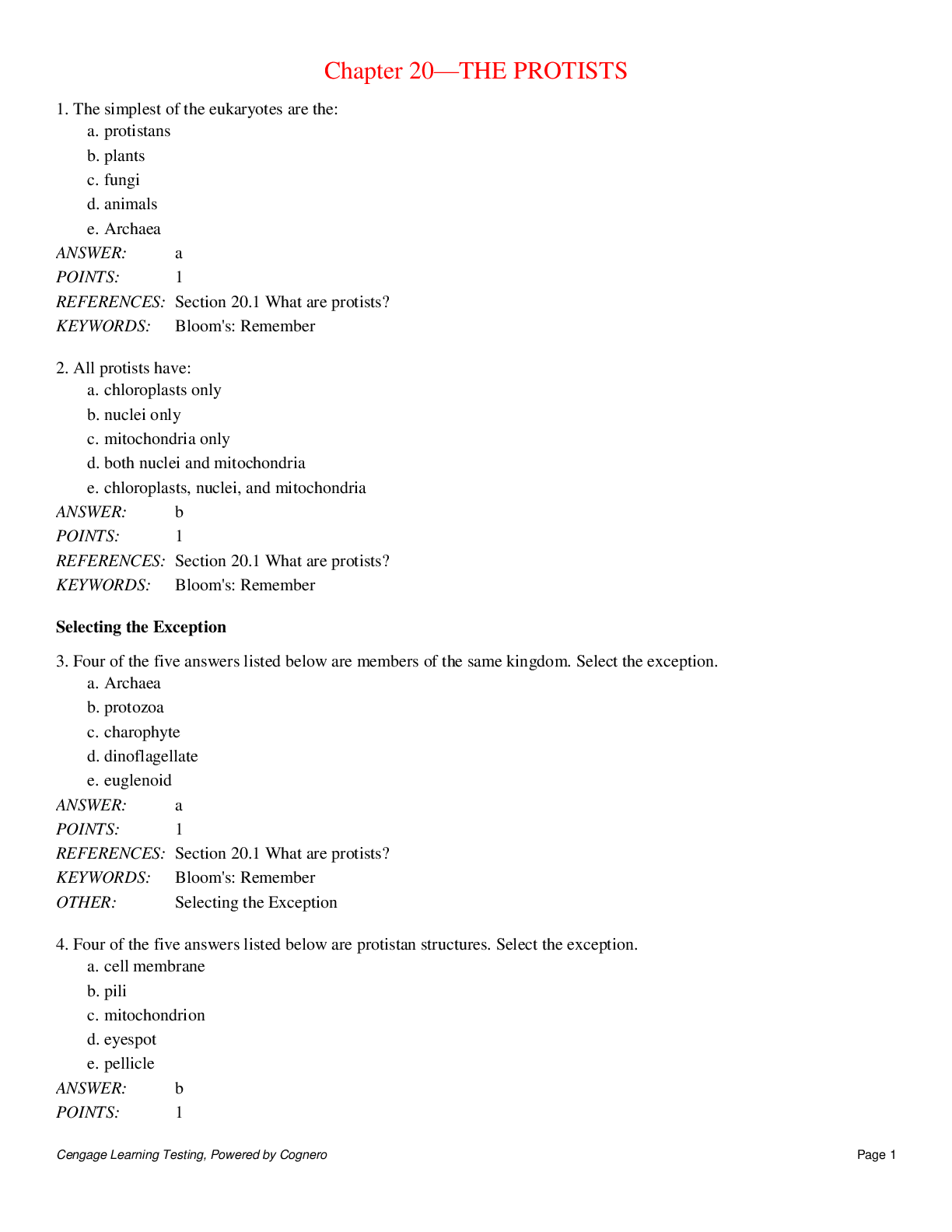
Reviews( 0 )
Document information
Connected school, study & course
About the document
Uploaded On
Nov 27, 2019
Number of pages
20
Written in
Additional information
This document has been written for:
Uploaded
Nov 27, 2019
Downloads
0
Views
45







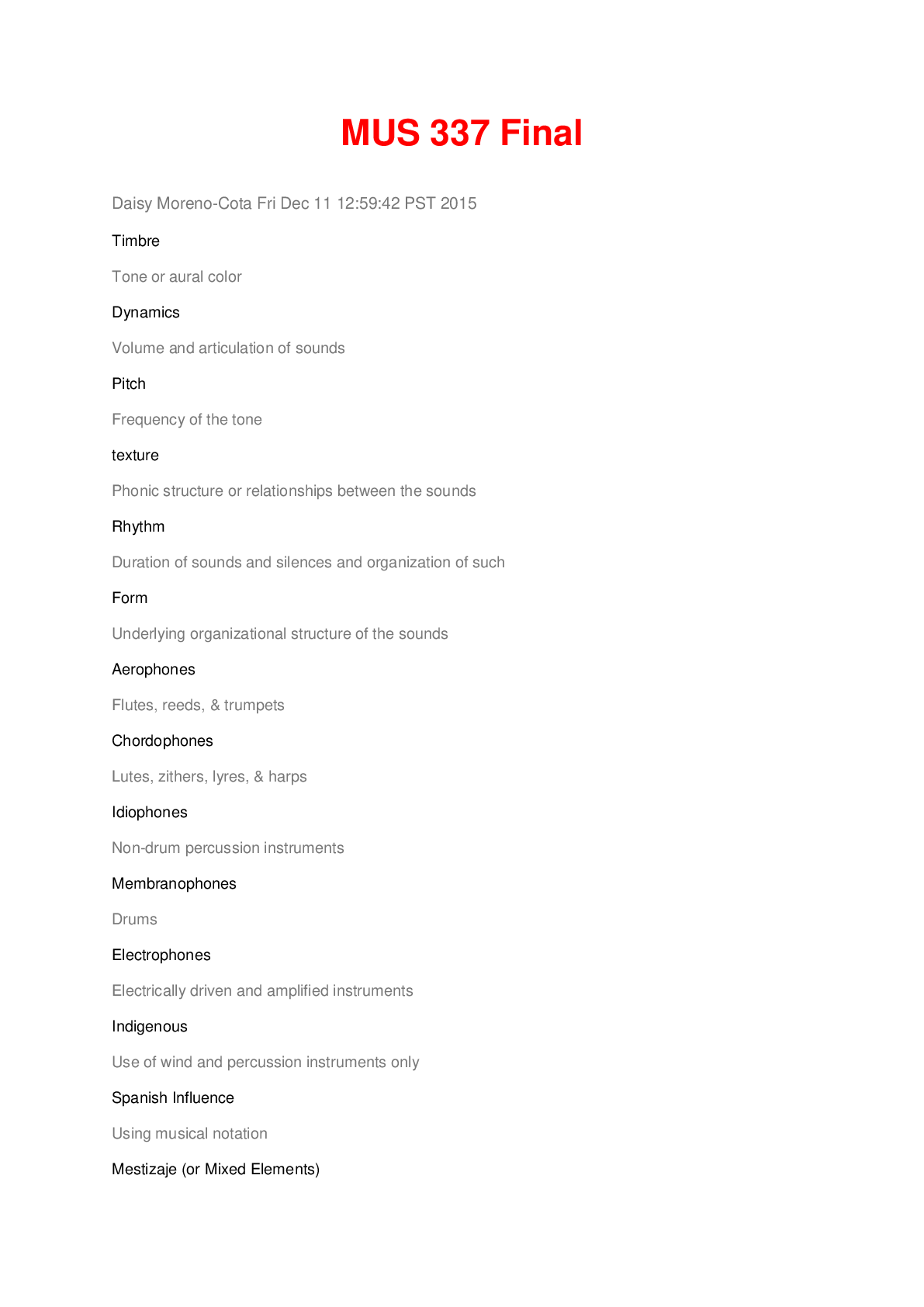




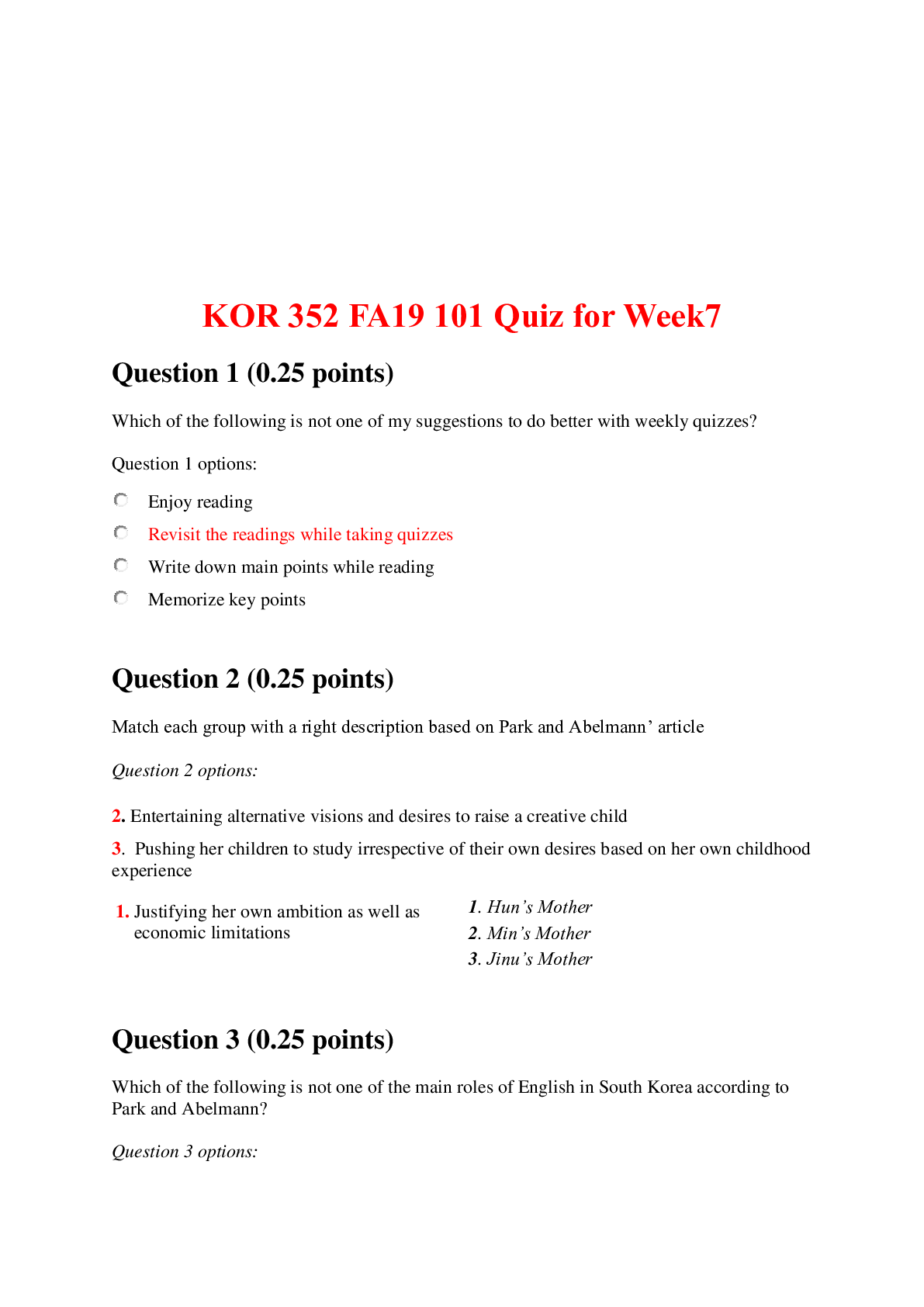


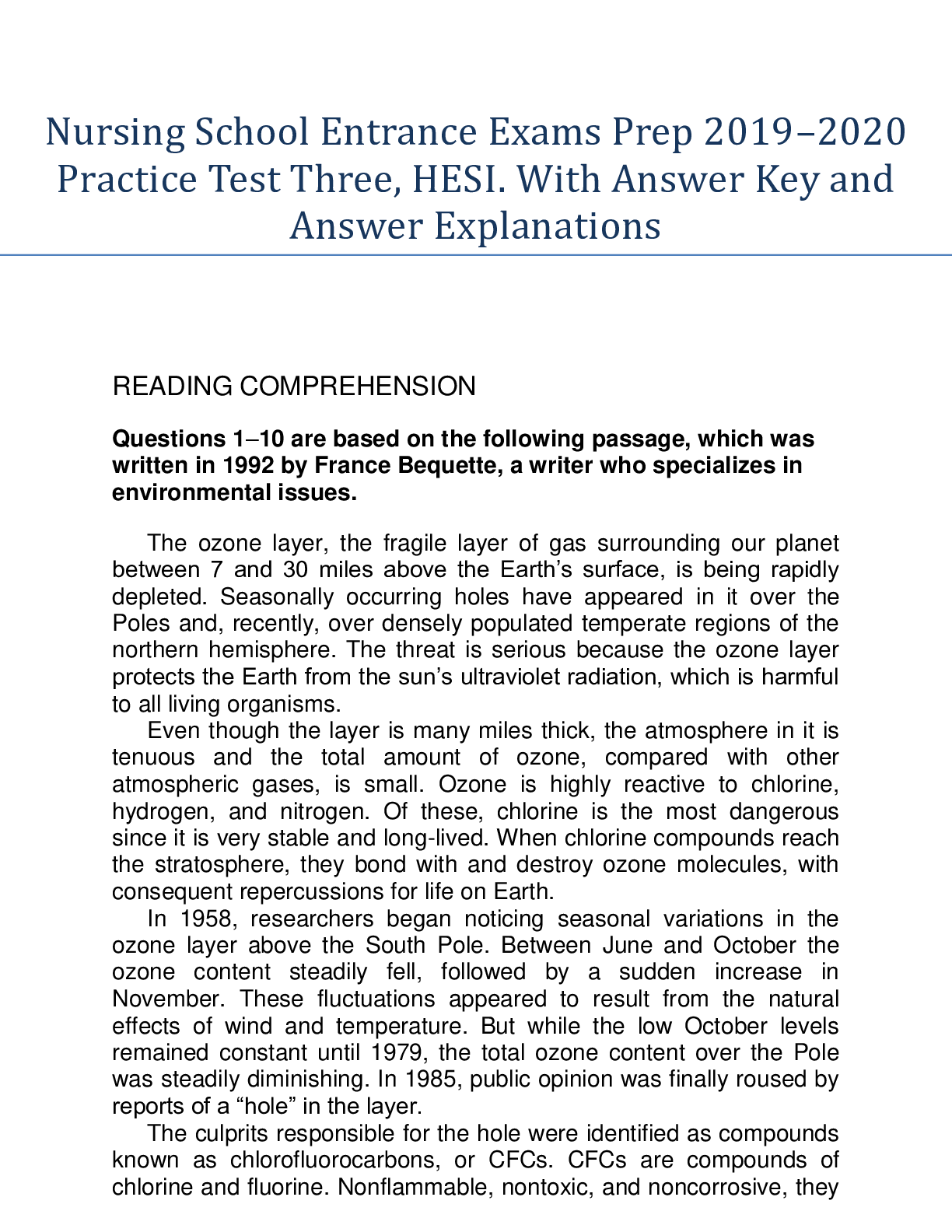
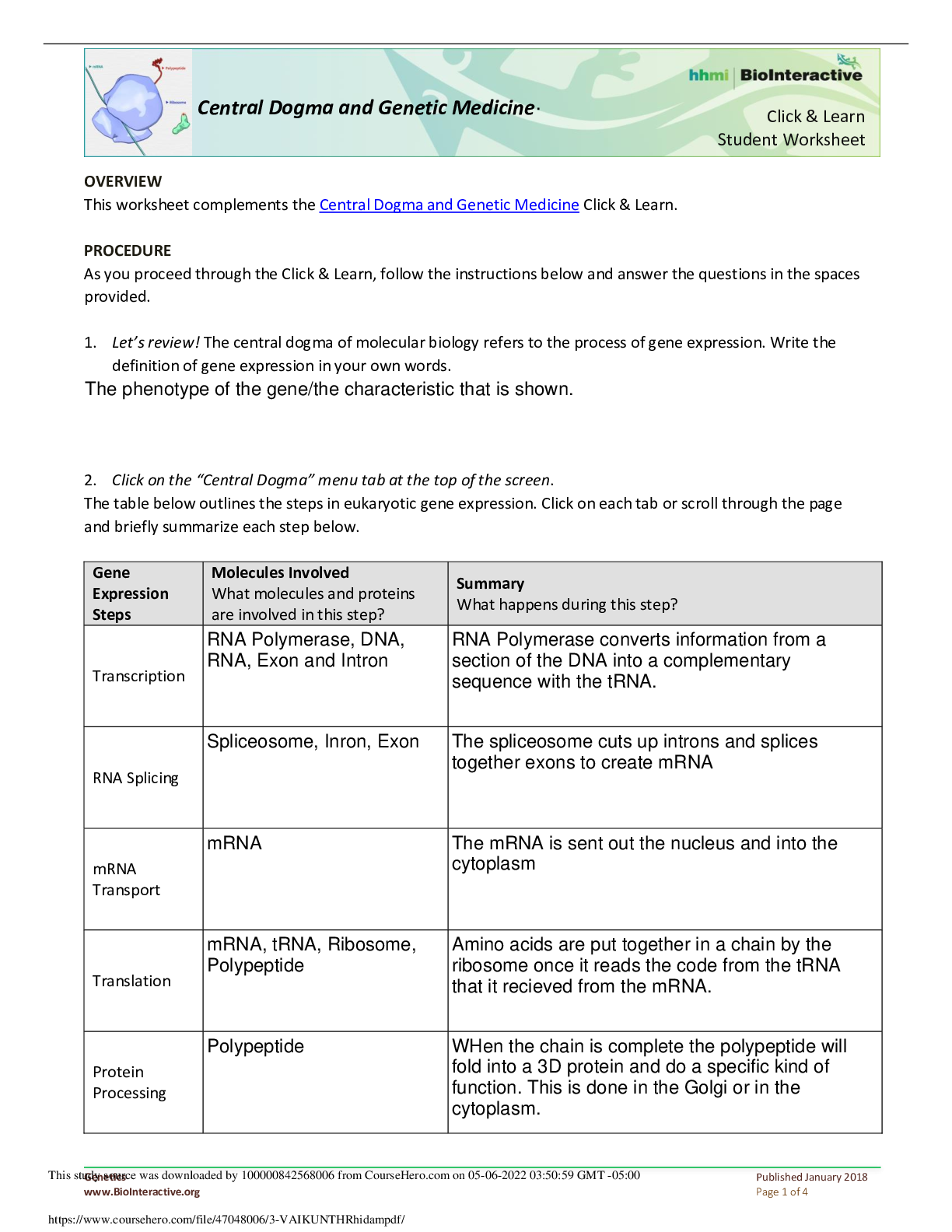


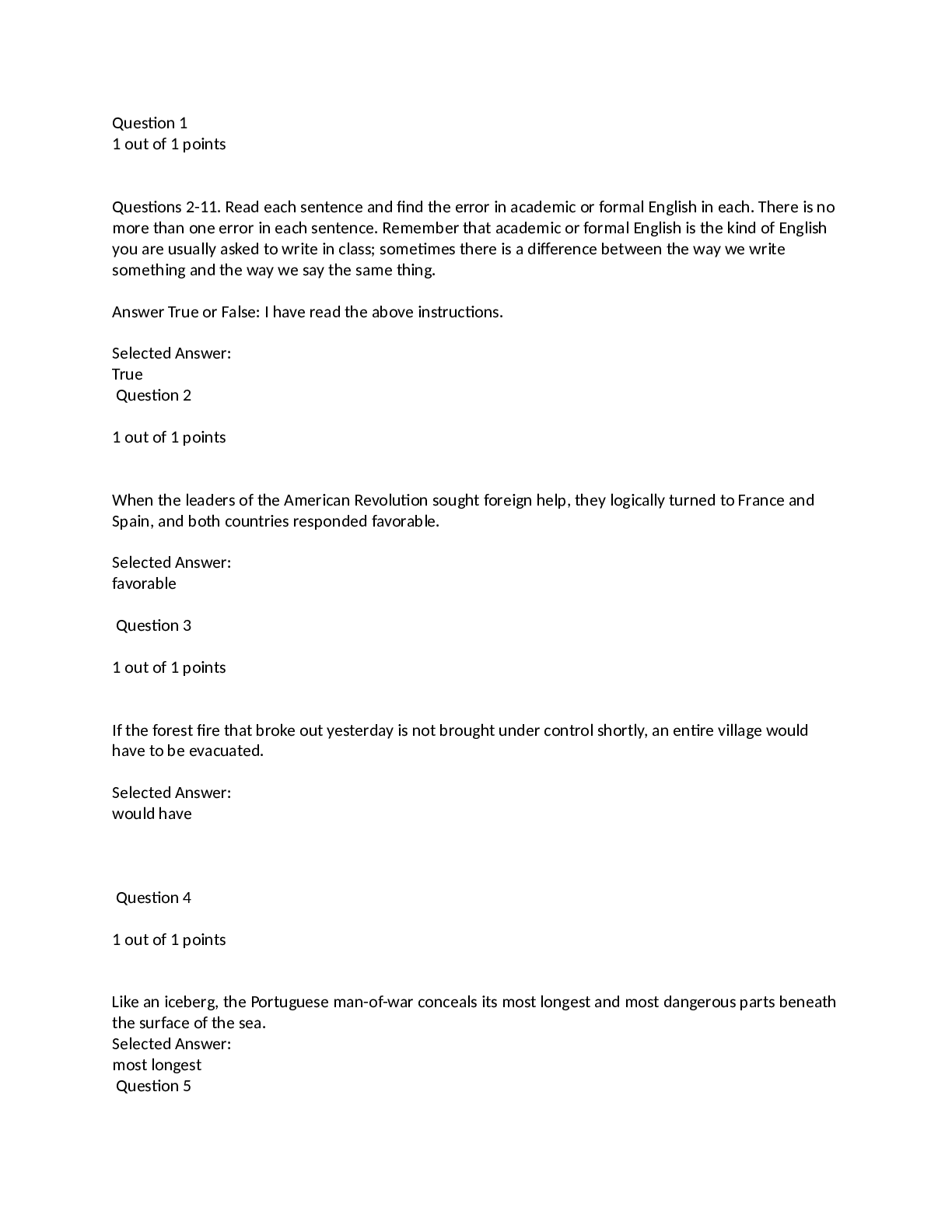
.png)
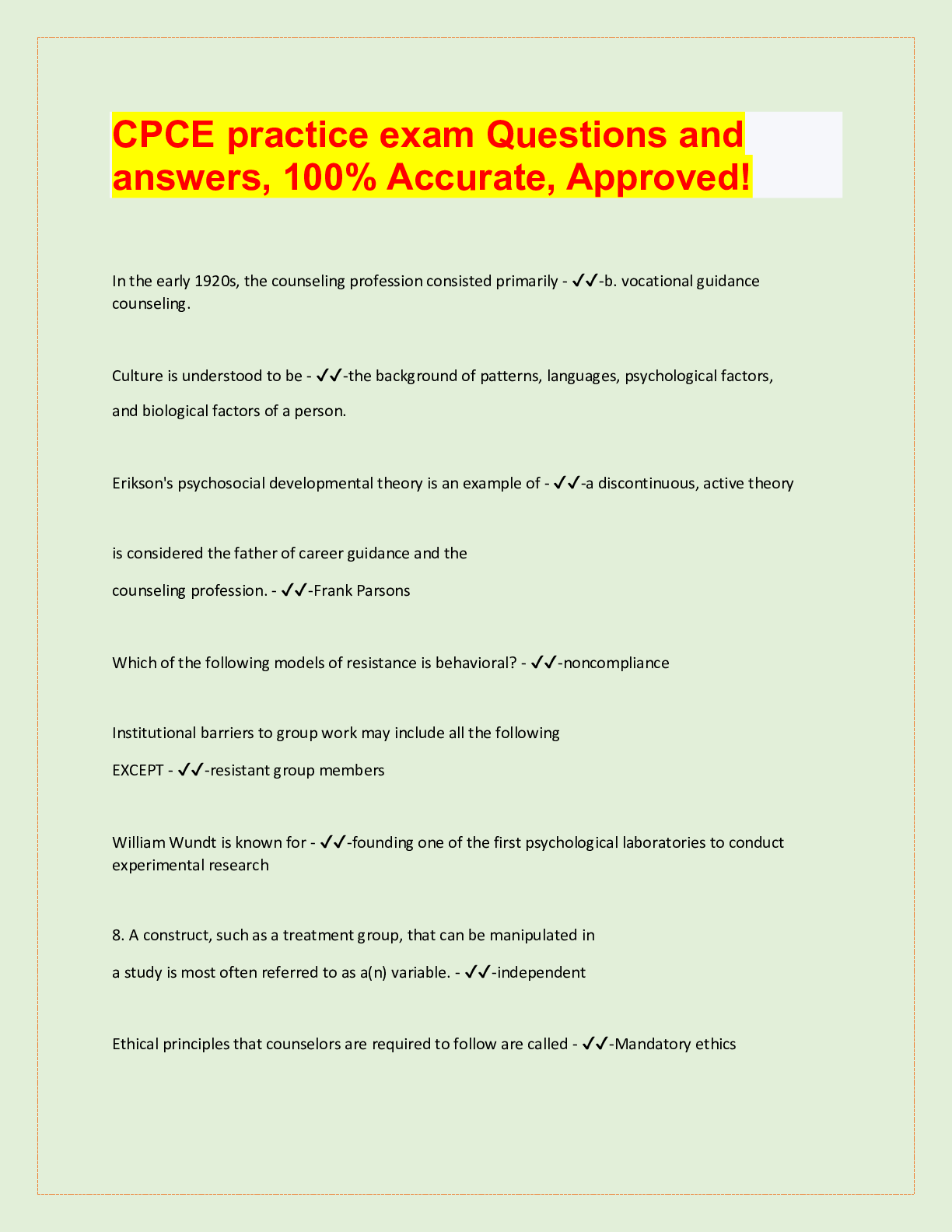
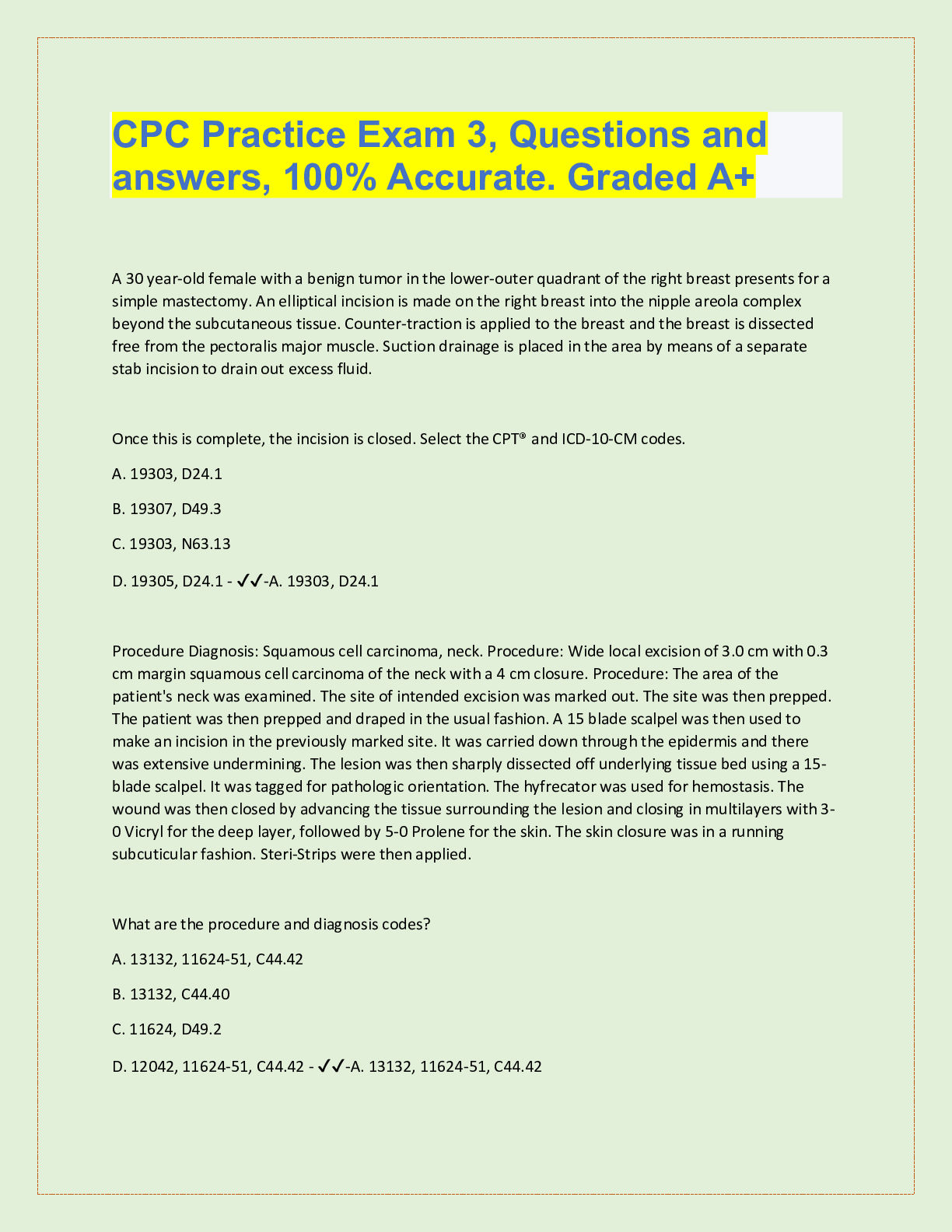
.png)


.png)


.png)

.png)
.png)
.png)

